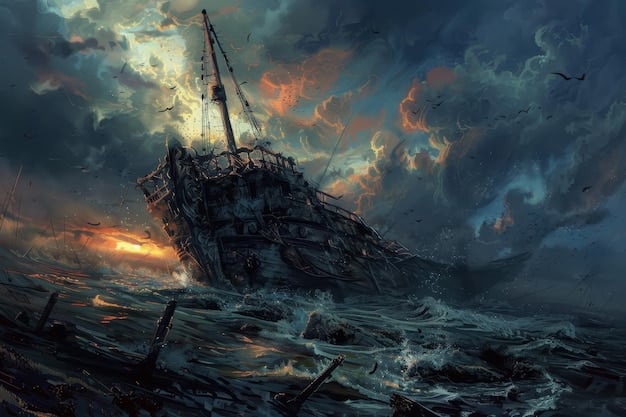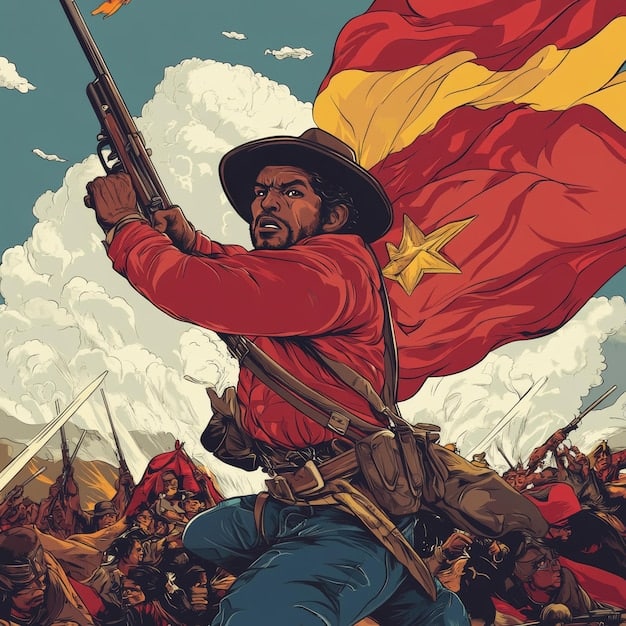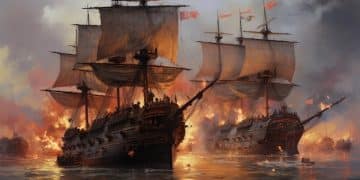The Spanish-American War: Causes, Consequences & Lasting Impact

The Spanish-American War, a pivotal conflict in 1898, stemmed from Cuban independence struggles and expansionist ambitions, resulting in significant territorial gains for the U.S. and reshaping global power dynamics.
The Spanish-American War: Uncovering the Causes and Consequences of the Conflict reveals a turning point in American history. Let’s explore the origins, key events, and lasting impact of this pivotal war that shaped the nation’s role on the global stage.
Unpacking the Origins of the Spanish-American War
The Spanish-American War wasn’t a sudden eruption. It stemmed from deep-seated tensions and long-standing issues. Two primary catalysts propelled the United States toward conflict.
Cuban Struggle for Independence
For decades, Cuba had been struggling for independence from Spanish colonial rule. The Cuban people endured oppressive conditions and sought self-determination. This desire for freedom fueled numerous revolts and uprisings against Spanish authority.
The United States, with its proximity to Cuba and its own revolutionary history, watched these events with increasing interest and sympathy. The plight of the Cuban people resonated with the American public, fostering a sense of solidarity and a growing call for intervention.
American Economic Interests
Beyond humanitarian concerns, economic interests also played a significant role in the United States’ involvement. American businesses had invested heavily in Cuba, particularly in sugar plantations. The instability caused by the Cuban struggle threatened these investments.
Furthermore, the United States saw Cuba as strategically important for controlling trade routes in the Caribbean. Intervention in Cuba presented an opportunity to secure these economic interests and expand American influence in the region.
The seeds of conflict were sown long before the first shots were fired, with Cuban aspirations for freedom intertwined with American strategic and economic ambitions.
The Role of Yellow Journalism
Sensationalism in media inflamed public opinion. Two prominent newspaper publishers, Joseph Pulitzer of the *New York World* and William Randolph Hearst of the *New York Journal*, engaged in a fierce circulation war.
This rivalry led them to exaggerate and fabricate stories about the situation in Cuba, a practice known as yellow journalism. Their sensational reports, often filled with graphic depictions of Spanish atrocities, ignited public outrage and intensified the pressure on the U.S. government to intervene.

- Exploitation of Emotions: Yellow journalism manipulated public emotions to create sensation.
- Inflammatory Headlines: Sensationalized headlines amplified feelings of anger and resentment towards Spain.
- Misleading Information: False information distorted the reality of the conflict, fueling the desire for war.
The impact of yellow journalism on the American public cannot be overstated. By shaping public perception and drumming up support for intervention, it significantly contributed to the outbreak of the Spanish-American War. It’s a stark reminder of the power of media to influence public opinion and shape historical events.
Media sensationalism fuelled the fire, manipulating public opinion and pushing the nation closer to war, highlighting the profound impact of media on historical events.
The Sinking of the USS Maine and the Declaration of War
The explosion of the USS Maine in Havana Harbor on February 15, 1898, became the tipping point that propelled the United States into war. The Maine had been sent to Havana to protect American citizens and interests during a period of heightened tensions. Its sudden destruction, with the loss of over 260 American sailors, sent shockwaves through the nation.
The Call for Retaliation
Although the exact cause of the explosion remains a subject of debate, the American public, fueled by yellow journalism, immediately blamed Spain. “Remember the Maine, to hell with Spain!” became a rallying cry for intervention. Politicians and citizens alike demanded retaliation, pushing President William McKinley toward war.
On April 25, 1898, the United States officially declared war on Spain. This declaration marked the beginning of a short but consequential conflict that would reshape the global landscape and solidify America’s position as a world power.
Consequences of the War Declaration
- Activation of forces: The United States mobilized its military and naval forces.
- Military engagements: Military operations started without any delay.
- Worldwide attention: It made America a superpower to be reckoned with.
The sinking of the USS Maine served as the ultimate catalyst, uniting a nation and leading to a declaration of war that would alter the course of both American and global history.
Key Battles and Events of the War
The Spanish-American War was a relatively brief conflict, lasting only a few months. However, it was marked by several key battles and events that decisively shaped its outcome.

One of the most notable battles took place in Manila Bay, Philippines, on May 1, 1898. The U.S. Asiatic Squadron, commanded by Commodore George Dewey, launched a surprise attack on the Spanish fleet stationed in the bay.
The Battle of Manila Bay
In a stunning victory, the American fleet decisively defeated the Spanish, destroying or capturing all of their ships without suffering a single American loss. This victory secured American control of Manila Bay and paved the way for the invasion and occupation of the Philippines.
Another significant event was the Battle of San Juan Hill in Cuba on July 1, 1898. This battle saw American forces, including the famed Rough Riders led by Theodore Roosevelt, charge up heavily defended Spanish positions. Despite suffering heavy casualties, the Americans captured San Juan Hill, a strategic victory that contributed to the eventual surrender of Santiago de Cuba.
The Battle of Santiago
The Battle of Santiago de Cuba on July 3, 1898, resulted in the destruction of the Spanish naval squadron. This secured the American naval superiority in the Caribbean.
These key battles, along with other engagements in Cuba and the Philippines, led to a swift and decisive American victory. The Spanish were outmatched in terms of naval power and military technology, and their colonial forces were unable to withstand the American onslaught.
Decisive battles in Manila Bay and San Juan Hill showcased American naval and military prowess, leading to swift victories and setting the stage for Spain’s ultimate defeat.
The Treaty of Paris and Territorial Gains
The Treaty of Paris, signed on December 10, 1898, formally ended the Spanish-American War. In this treaty, Spain ceded Cuba, Puerto Rico, and Guam to the United States. Spain also sold the Philippines to the United States for $20 million.
America as a World Power
These territorial acquisitions marked a significant expansion of American power and influence overseas. The United States emerged from the war as a major world power, with a growing empire that stretched across the Caribbean and the Pacific. This new status had profound implications for American foreign policy and its role in international affairs.
However, the acquisition of these territories also sparked debate within the United States. Some Americans welcomed the expansion of American power and influence, viewing it as a fulfillment of Manifest Destiny (the belief that the United States was destined to expand across the North America). Others were concerned about the implications of colonialism and the impact on the people living in these newly acquired territories.
Anti-Imperialist views
The people of Cuba, Puerto Rico, and the Philippines had mixed reactions to the treaty. Some welcomed the end of Spanish colonial rule and hoped for self-government. Others were wary of American intentions and feared that the United States would simply replace Spain as their colonial master.
The Treaty of Paris fundamentally reshaped the geopolitical map, ushering in a new era of American expansionism and prompting debates about the responsibilities and consequences of empire.
Long-Term Consequences and Legacy
The Spanish-American War had long-lasting consequences for the United States and the world. It marked a turning point in American history, solidifying the nation’s position as a major global power and shaping its foreign policy for decades to come.
Impact on American Foreign Policy
The war demonstrated the United States’ willingness to intervene in foreign affairs to protect its interests and promote its values. This interventionist approach became a defining characteristic of American foreign policy in the 20th century.
Aftermath of the War
The war also had a significant impact on the people of Cuba, Puerto Rico, and the Philippines. While Cuba eventually gained its independence, the United States maintained a significant degree of influence on the island’s affairs. Puerto Rico became a U.S. territory, and its people were granted American citizenship. The Philippines, however, faced a long and bloody struggle for independence from American rule.
- Cuban Independence (with caveats): Cuba obtained independence but with American influence, shaping the island’s future.
- American Territory: Puerto Rico became and remains a U.S. territory.
- Philippine-American War: The Philippines fought a bloody war for independence from the United States.
The Spanish-American War remains a subject of historical debate. Some historians view it as a justified intervention to liberate oppressed peoples and promote American ideals. Others criticize it as an act of imperialist aggression that violated the principles of self-determination.
The war’s legacy is complex and multifaceted, marked by shifts in American foreign policy, struggles for self-determination in former colonies, and ongoing debates about imperialism and American values.
| Key Point | Brief Description |
|---|---|
| 🔥 USS Maine Sinking | Catalyzed US intervention, sparking the war. |
| 📰 Yellow Journalism | Sensationalized news, inflaming public opinion for war. |
| 🌍 Territorial Gains | US acquired Cuba, Puerto Rico, Guam, and the Philippines. |
| 🇺🇸 Emergence as Power | The war positioned the US as a major global superpower. |
Frequently Asked Questions
▼
The main causes included Cuba’s struggle for independence from Spain, American economic interests in Cuba, and the rise of yellow journalism, which sensationalized events and fueled public support for war.
▼
Yellow journalism exaggerated Spanish atrocities in Cuba, stirring up public outrage in the United States and pushing the government towards intervention. It significantly shaped public opinion and support for the war.
▼
The United States gained Cuba, Puerto Rico, and Guam from Spain. It also purchased the Philippines for $20 million, expanding American influence across the Caribbean and the Pacific.
▼
The war marked a shift toward interventionism in American foreign policy. It demonstrated the US’s willingness to intervene abroad to protect its interests, shaping its role on the global stage in the 20th century.
▼
Cuba gained independence but remained under significant American influence. The Philippines, however, faced a bloody war for independence from the United States, highlighting the complex legacy of the conflict.
Conclusion
The Spanish-American War remains a fascinating topic of study, revealing the complex interplay of political, economic, and social forces that shaped a pivotal moment in American history. By understanding the causes and consequences of this conflict, we can gain valuable insights into the evolution of American foreign policy and the enduring legacies of imperialism.





